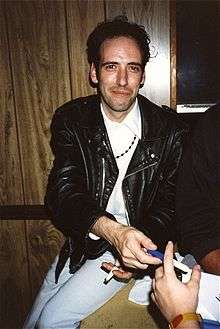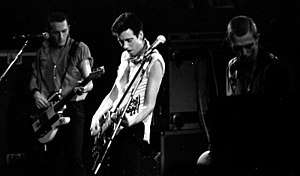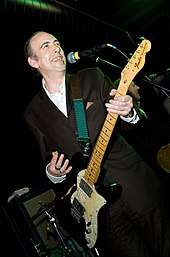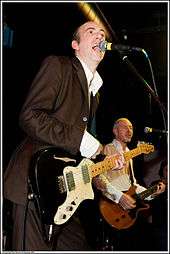Mick Jones (The Clash guitarist)
Michael Geoffrey Jones (born 26 June 1955) is a British musician, singer and songwriter best known as the lead guitarist, co-lead vocalist, co-founder and songwriter for The Clash until 1983. In 1984, he formed Big Audio Dynamite with Don Letts. Jones has played with the group Carbon/Silicon along with Tony James since 2002 and was part of the Gorillaz live band for a world tour in 2010-2011. In late 2011, Jones collaborated with Pete Wylie and members of the Farm to form the Justice Tonight Band.
Mick Jones | |
|---|---|
 Jones during his stint with Big Audio Dynamite (New York, 1987) | |
| Background information | |
| Birth name | Michael Geoffrey Jones |
| Born | 26 June 1955 Wandsworth, London, England |
| Genres | Punk rock, post-punk, new wave, experimental rock, alternative rock |
| Occupation(s) | Musician, songwriter |
| Instruments | Guitar, vocals, bass guitar, keyboards, drums, harmonica |
| Years active | 1975–present |
| Labels | CBS, I.R.S., Radioactive |
| Associated acts | The Clash, General Public, Big Audio Dynamite, Carbon/Silicon, Gorillaz, London SS, The Wallflowers, The Libertines, Aztec Camera, The Flaming Lips |
Early life
Michael Geoffrey Jones was born on 26 June 1955 in Wandsworth, London, England, to a Welsh father, Tommy Jones, and a Russian Jewish mother, Renee Zegansky.[1] He spent much of his early life living with his maternal grandmother, Stella Class, in South London. Jones' cousin is Grant Shapps, the Conservative MP for Welwyn Hatfield.[2] Jones went to Strand School in South London and West London School of Art And Design, because "[he] thought that's how you get into bands and stuff".[3]
But even before The Dolls, I used to follow bands around. I followed Mott the Hoople up and down the country. I'd go to Liverpool or Newcastle or somewhere—sleep on the Town Hall steps, and bunk the fares on the trains, hide in the toilet when the ticket inspector came around. I'd jump off just before the train got to the station and climb over the fence. It was great times, and I always knew I wanted to be in a band and play guitar. That was it for me.
— Mick Jones to Gibson Backstage Pass Holiday Double Issue 2006[4]
He started gaining recognition as a guitarist in the early 1970s with his glam rock band, The Delinquents. A short time later, he met Tony James and formed the protopunk London SS. By 1976, that band had broken up and remaining members Jones, Paul Simonon and Keith Levene were seeking a new direction.[5]
The Clash

When he was 21, he and Paul Simonon were introduced to Joe Strummer by Bernie Rhodes[6] in a squat in Shepherd's Bush. The band rehearsed in a former railway warehouse in Camden Town and The Clash was formed. Jones played lead guitar, sang, and co-wrote songs from the band's inception until he was fired by Strummer and Simonon in 1983. One of the songs he wrote, "Train in Vain," was allegedly about Jones' relationship with Viv Albertine, guitarist of The Slits. Jones' lack of punctuality played a major role in his dismissal from the band. Jones agreed to give a rare interview about the disintegration of The Clash and the reasons behind his dismissal from 'his own band' in Danny Garcia's 2012 documentary film and book The Rise and Fall of the Clash.[7]
For his time with The Clash, Jones, along with the rest of the band, was inducted into the Rock and Roll Hall of Fame in 2003.[8]
While promoting the band's 2013 box set, Sound System, which Jones says will be the final time he works on Clash music, he discussed the band reuniting prior to Strummer's death.
There were a few moments at the time I was up for it (Hall of Fame reunion in 2003), Joe was up for it. Paul wasn't. And neither, probably, was Topper Headon, who didn't wind up even coming in the end. It didn't look like a performance was going to happen anyway. I mean, you usually play at that ceremony when you get in. Joe had passed by that point, so we didn't. We were never in agreement. It was never at a point where all of us wanted to do it at the same time. Most importantly for us, we became friends again after the group broke up, and continued that way for the rest of the time. That was more important to us than the band.[9]
In an October 2013 interview with BBC 6Music, Jones confirmed that Strummer did have intentions of a Clash reunion and in fact new music was being written for a possible album. In the months prior to Strummer's death, Jones and Strummer began working on new music for what he thought would be the next Mescaleros album. Jones said "We wrote a batch – we didn't use to write one, we used to write a batch at a time – like gumbo. The idea was he was going to go into the studio with the Mescaleros during the day and then send them all home. I'd come in all night and we'd all work all night." Jones said months had passed following their work together when he ran into Strummer at an event. Jones was curious as to what would become of the songs he and Strummer were working on and Strummer informed him that they were going to be used for the next Clash album.[10]
General Public
After his expulsion from the Clash, Jones was a founding member of General Public. Though he is listed in the credits of the band's 1984 debut album All the Rage as a member, Jones left General Public part way through the recording process and was replaced by Kevin White. White's picture appears on the back cover; Jones' picture does not. Jones did play guitar on many of the album's tracks, including the North American top 40 single "Tenderness".
Big Audio Dynamite
Leaving General Public behind, in 1984 Jones formed Big Audio Dynamite with film director Don Letts, who had directed various Clash videos and later the Clash documentary Westway to the World. The band's début album This Is Big Audio Dynamite was released the following year, with the song "E=MC²" getting heavy rotation in dance clubs, and both singles "Medicine Show" and "E=MC2" charting in the UK.
For Big Audio Dynamite's second album, No. 10, Upping St., Jones reunited with Strummer. Together, the two wrote several songs on the album, including "Beyond the Pale", "V. Thirteen", and "Sightsee M.C!"; Strummer also co-produced the album. Their reunion did not last long, and following that collaboration, the two did not work together again for some time.
Big Audio Dynamite's third album, Tighten Up, Vol. 88, featured album cover art painted by the ex-Clash bassist, Paul Simonon. Shortly following its release, Jones developed chickenpox and pneumonia, and spent several months in hospital.[11][12] After his recovery, Jones released one more album with Big Audio Dynamite, Megatop Phoenix, before reshuffling the line-up, renaming the band Big Audio Dynamite II and releasing The Globe album. The BAD II lineup had an international #1 hit with their song "Rush", topping the Billboard Modern Rock charts in the U.S. and singles charts in Australia and New Zealand.
In 1990, Jones was featured on Aztec Camera's song "Good Morning Britain", with Roddy Frame.
The band's lineup was reshuffled again in 1994, and they released the album Higher Power under the name Big Audio. In 1995, a greatest hits album, Planet B.A.D. was released as well as a studio album called F-Punk under the original Big Audio Dynamite name. A further album, Entering a New Ride was recorded in 1997, but was only released on the internet because of a disagreement with Radioactive Records, their then record label. One more "best of" collection, called Super Hits, was released in 1999.
Jones announced the reuniting of Big Audio Dynamite in January 2011, and they performed at the Lollapalooza music festival in 2011.
Recent projects
Carbon/Silicon

In 2002, Jones teamed up with his former London SS colleague, Generation X and Sigue Sigue Sputnik member Tony James to form a new band named Carbon/Silicon. The band has toured the United Kingdom and the United States and has performed a number of anti-fascist benefit concerts; they have also recorded three albums: A.T.O.M, Western Front and The Crackup Suite which were available online for free. Their first physical CD release was The News EP. The band encourages their fans to share their music on P2P networks, and allow the audio and video taping of their shows. Their first song, "MPFree" is an anthem for P2P file sharing.
Similar in many respects to Jones' earlier work in Big Audio Dynamite, Carbon/Silicon aims to break the traditional approach to rock and roll. The band was described by Alan McGee as "...the Stones jamming with a laptop," and they make use of samples in their recordings and live shows. The formation of the band was catalysed by the internet and p2p file sharing. The first song written by Jones and James was entitled "MPFree," in which they expressed their willingness to embrace the technology of the internet and file sharing, in the interest of spreading music, rather than profit.
On seven consecutive Friday nights in January and February 2008 Carbon/Silicon played a series of gigs at the Inn on the Green, right under the Westway in Thorpe Close, between Ladbroke Grove and Portobello Road, London. As well as Carbon/Silicon there were many special guests, including appearances by Sex Pistols' Paul Cook and Glen Matlock, former Clash drummer Topper Headon and multi-instrumentalist and former Mescalero, Tymon Dogg.
Producer
Jones has also been an occasional producer. In 1981 he produced Ellen Foley's second album Spirit of St. Louis. Jones was in a relationship with Foley, and co-wrote songs for the album with Strummer and Tymon Dogg. Players on the album included members of the Blockheads, Tymon Dogg and all four members of the Clash.[13]
In 1981, Jones co-produced Ian Hunter's Short Back 'n' Sides LP with Mick Ronson. He also provided guitars and vocals for several songs on the release. In the same year, he produced Theatre of Hate's first album Westworld released in 1982, written by Kirk Brandon. Jones also played guitar on the title track, "Do You Believe in the Westworld". Jones would also record and produce Aria of the Devil in 1982 by Theatre of Hate at Wessex Studios, which did not get released until 1998, when the master tapes were found by Kirk Brandon.
He produced the London-based band the Libertines' debut album Up The Bracket (2002); Jones stayed on to produce the band's second album The Libertines (2004).[14] He also produced Down in Albion, the debut album of former Libertines lead singer and guitarist Pete Doherty's new group Babyshambles.[15]
In 2014 he produced sibling band Kitty, Daisy & Lewis' album The Third.[16]
Jones is also credited with contributing guitar and vocals to "Mal Bicho", the lead track of Los Fabulosos Cadillacs' album Rey Azucar.
He provided the score for Nick Mead's film, Dice Life – the Random Mind of Luke Rhinehart, a contemporary dance film created by Nick Mead and Wayne McGregor, featuring Luke Rhinehart, author of The Dice Man.
At the NME Shockwave 2007 awards, Jones took to the stage and performed "(White Man) In Hammersmith Palais" with Primal Scream.[17]
Gorillaz
Jones reunited with Simonon on the title track of Gorillaz's 2010 album Plastic Beach: both of them performed in the Gorillaz live band supporting Plastic Beach. The band headlined the 2010 Coachella Festival, Glastonbury and Festival Internacional de Benicassim. Jones later appeared on the 2011 Gorillaz album The Fall on the track "Amarillo".
The Justice Tonight Band
In late 2011, Jones agreed to play songs by the Clash live again, collaborating with Pete Wylie and members of the Farm to form The Justice Tonight Band. The band formed with the aim of promoting awareness of the Hillsborough Justice Campaign. The Justice Tonight band have been joined onstage at different gigs by several other musicians sympathetic to the cause, including Billy Bragg and Paul Simonon. Shane MacGowan joined them onstage in Phoenix Park when The Justice Tonight Band supported the Stone Roses as part of their Reunion Tour on 5 July 2012.
The Wallflowers
Jones collaborated with alternative rock group the Wallflowers as a guitarist and backing vocals for two tracks on their 2012 album Glad All Over.[18]
Rachid Taha
Mick Jones was a featured guest on Rachid Taha's Zoom album (2013) (together with Brian Eno) and Jones toured with Rachid Taha as part of the Zoom project.[19][20]
The Flaming Lips
Jones narrated the King's Mouth album by The Flaming Lips, released on 20 April 2019 which is Record Store Day. Jones is also featured on the album's cover artwork. The Flaming Lips's singer Wayne Coyne said of Jones "he’s on almost every song... it really is quite unbelievable."[21]
Musical equipment

Jones' first guitar was a Gibson Les Paul Junior with a P-90 pickup, which he bought because Johnny Thunders used one. The Junior was his main guitar up until late 1977 or early 1978, and after that as a backup and studio guitar. Around the same time he also owned another Les Paul Junior, all black (formerly red) with a black pick guard, which was smashed at a performance in 1977. He then switched to a Gibson Les Paul Standard and later to Gibson Les Paul Customs.
Jones also occasionally played an Olympic White Fender Stratocaster (for live versions of "Straight to Hell") and several Bond Electraglide guitars that were donated to him by Andrew Bond, who made the guitars. For effects Jones mainly uses MXR pedals including a Phase 100, a flanger, an analog delay and a noise gate as well as a Roland chorus or Space Echo effect.[22] During his days with the Clash, Jones used a Marshall Plexi amplifier and occasionally a Fender Twin with a 2x12 cabinet. He later changed to a Mesa Boogie amplifier with two Marshall 4x12 cabinets that he used throughout the rest of his career with the Clash.[23]
References
- Gray, Marcus (2010). Route 19 Revisited: The Clash and London Calling. Soft Skull Press. ISBN 1593763913.
- Newsnight, BBC2, 14 April 2010
- Letts Don; Rick Elgood, Joe Strummer, Mick Jones, Paul Simonon, Topper Headon, Terry Chimes, The Clash (2001). The Clash: Westway to the World (Documentary). New York, NY: Sony Music Entertainment; Dorismo; Uptown Films. Event occurs at 3:50–4:50. ISBN 0-7389-0082-6. OCLC 49798077.
- "Stay Free: Mick Jones Looks Back at The Clash". Gibson Backstage Pass Holiday Double Issue 2006. Gibson.com. December 2006. Archived from the original on 30 June 2008. Retrieved 17 December 2007.
But even before the Dolls, I used to follow bands around. I followed Mott the Hoople up and down the country. I'd go to Liverpool or Newcastle or somewhere—sleep on the Town Hall steps, and bunk the fares on the trains, hide in the toilet when the ticket inspector came around. I'd jump off just before the train got to the station and climb over the fence. It was great times, and I always knew I wanted to be in a band and play guitar. That was it for me.
- Renshaw, Jerry (22 May 2000). "From Here to Eternity – The Story of the Clash". The Austin Chronicle. Austin, Texas: Austin Chronicle. OCLC 32732454.
When Mick Jones finally began attracting attention for his guitar playing, he was in a glam rock outfit, the Delinquents, complete with long hair, feather boas, and poncey trappings; in time he would meet up with Tony James (later of Generation X and Sigue Sigue Sputnik) to form the London SS. With a revolving-door cast of players including future members of the Damned, Chelsea, and PiL, London SS took the first stack-heeled, shambling steps toward punk, naming among their influences the Stooges, MC5, and New York Dolls, and in the process acquiring future Clash manager Bernie Rhodes. By 1976, London SS had fallen apart, and Jones found himself in a new band with guitarist Keith Levene and art-school drop-out Paul Simonon. Simonon had spent much of his time hanging out with his West Indian pals and immersing himself in reggae, ska, and skinhead fashions, elements that would later be part and parcel of the Clash. Meanwhile, in another part of London, 24-year-old John Mellor was bashing away in pub-rock outfit the 101ers. The band caught the interest of Simonon and Jones, still in search of a front-man to round out their line-up.
Related news articles:- "Music: From Here to Eternity". The Austin Chronicle. weekly WIRE.com. 22 May 2000. Retrieved 17 December 2007.
- In a television interview, Strummer said, after drawing the camera to Bernard sleeping against a wall, "He invented punk ... it was obviously too much for him", referring ironically to a statement of Rhodes himself. The scene and the statement are featured in the documentary Joe Strummer: The Future Is Unwritten.
- Garcia, Danny (2012). The Rise and Fall of the Clash. London: Thin Man Press. ISBN 9780956247322.
- "The Clash – Induction". The Rock and Roll Hall of Fame and Museum. 10 March 2003. Archived from the original on 30 April 2010. Retrieved 19 November 2007.
- Andy Greene (30 August 2013). "Mick Jones on Clash Box Set | Music News". Rolling Stone. Retrieved 20 May 2014.
- "The Clash – Mick Jones: 'Secret Joe Strummer Tunes Could Have Sparked The Clash's Comeback'". Contact Music. Retrieved 4 October 2013.
- Robbins, Ira Robbins; Jem Aswad; Michael Azerrad. "TrouserPress.com :: Big Audio Dynamite" (PHP). TrouserPress.com. Retrieved 17 December 2007.
The disappointing Tighten Up Vol. 88 reaches no such peaks and now sounds like a fairly brazen attempt to get hip commercial airplay. The fault is seldom with Jones' songwriting but more with the slick sheen laid over the leaner, less aggressive beats. The LP yielded "Just Play Music" and "Other 99," but a pall was thrown on the release as Jones fell deathly ill shortly after its appearance; having contracted pneumonia, he was hospitalized for months.
- "Punk Legends Form Rock Band Carbon/Silicon". National Public Radio: Music. Retrieved 29 January 2008.
- Allmusic.com
- Hewitt, Ben (16 July 2009). "Mick Jones To Produce New Libertines Album?". The Quietus. Retrieved 25 July 2019.
- Kootnikoff, David (3 November 2005). "Babyshambles: Down in Albion". PopMatters. Retrieved 25 July 2019.
- Evans, Greg (16 June 2015). "Kitty, Daisy & Lewis Talk New Album and Working with the Clash's Mick Jones". Guitarworld.com. Retrieved 25 July 2019.
- ChartAttack.com Staff (2 March 2007). "Doherty And Moss' Naughtiness Overshadows Arctic Monkeys at NME Awards". News. Chart Communications. Archived from the original (CFM) on 7 June 2011. Retrieved 27 April 2009.
Jones joined Primal Scream to close the show with a cover of The Clash's "(White Man) In Hammersmith Palais," which was performed in honour of the storied venue's imminent closing. Primal Scream also played "Movin' On Up", "Country Girl", "Rocks" and "Swastika Eyes".
- Finley, Adam (18 October 2012). "The Wallflowers: Glad All Over". PopMatters. Retrieved 25 July 2019.
- "Trans Musicales de Rennes 2012 : 12 concerts à ne pas louper". FranceTVinfo – Culturebox. 4 December 2012. Retrieved 8 November 2014.
- John Lewis (26 June 2013). "Rachid Taha/Souad Massi – review (Barbican, London)". The Guardian. Retrieved 12 November 2014.
- "The Flaming Lips Announce New Album 'King's Mouth'". Exclaim!. Retrieved 10 January 2019.
- Archived 23 August 2001 at the Wayback Machine
- "Interview with Mick Jones". Web.archive.org. 27 October 2009. Archived from the original on 27 October 2009. Retrieved 20 May 2014.
Further reading
- Clash, The (1 October 2008). The Clash: Strummer, Jones, Simonon, Headon. London: Atlantic Books. ISBN 1-84354-788-0. OCLC 236120343.
- Gilbert, Pat (2005) [2004]. Passion Is a Fashion: The Real Story of The Clash (4th ed.). London: Aurum Press. ISBN 1-84513-113-4. OCLC 61177239.
- Gray, Marcus (2005) [1995]. The Clash: Return of the Last Gang in Town (5th revised ed.). London: Helter Skelter. ISBN 1-905139-10-1. OCLC 60668626.
- Green, Johnny; Garry Barker (2003) [1997]. A Riot of Our Own: Night and Day with The Clash (3rd ed.). London: Orion. ISBN 0-7528-5843-2. OCLC 52990890.
- Gruen, Bob; Chris Salewicz (2004) [2001]. The Clash (3rd ed.). London: Omnibus. ISBN 1-903399-34-3. OCLC 69241279.
- Needs, Kris (25 January 2005). Joe Strummer and the Legend of the Clash. London: Plexus. ISBN 0-85965-348-X. OCLC 53155325.
- Topping, Keith (2004) [2003]. The Complete Clash (2nd ed.). Richmond: Reynolds & Hearn. ISBN 1-903111-70-6. OCLC 63129186.